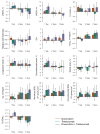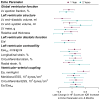Detailed Echocardiographic Phenotyping in Breast Cancer Patients: Associations With Ejection Fraction Decline, Recovery, and Heart Failure Symptoms Over 3 Years of Follow-Up
- PMID: 28104715
- PMCID: PMC5388560
- DOI: 10.1161/CIRCULATIONAHA.116.023463
Detailed Echocardiographic Phenotyping in Breast Cancer Patients: Associations With Ejection Fraction Decline, Recovery, and Heart Failure Symptoms Over 3 Years of Follow-Up
Abstract
Background: Cardiovascular disease in patients with breast cancer is of growing concern. The longitudinal effects of commonly used therapies, including doxorubicin and trastuzumab, on cardiac remodeling and function remain unknown in this population. We aimed to define the changes in echocardiographic parameters of structure, function, and ventricular-arterial coupling, and their associations with left ventricular ejection fraction (LVEF) and heart failure symptoms.
Methods: In a longitudinal prospective cohort study of 277 breast cancer participants receiving doxorubicin (Dox), trastuzumab (Tras), or both (Dox+Tras), we obtained 1249 echocardiograms over a median follow-up of 2.0 (interquartile range, 1.0-3.0) years. Left ventricular structure, diastolic and contractile function, and ventricular-arterial coupling measures were quantified in a core laboratory blinded to participant characteristics. We evaluated changes in echocardiographic parameters over time, and used repeated-measures regression models to define their association with LVEF decline and recovery. Linear regression models defined the association between early changes in these parameters and subsequent changes in LVEF and heart failure symptoms.
Results: Overall, 177 (64%) received Dox, 51 (18%) received Tras, and 49 (18%) received Dox+Tras. With Dox, there was a sustained, modest decrease in LVEF over the follow-up duration (1-year change in LVEF -3.6%; 95% confidence interval [CI], -4.4% to -2.8%; 3-year change -3.8%; 95% CI, -5.1% to -2.5%). With Tras, a similar LVEF decline was observed at 1 year (-4.5%; 95% CI, -6.0% to -2.9%) and 3 years (-2.8%; 95%CI, -5.3 to -0.4%). Participants receiving Dox+Tras demonstrated the greatest declines at 1 year (-6.6%; 95% CI, -8.2 to -5.0%), with partial recovery at 3 years (-2.8%; 95% CI, -4.8 to -0.8%). LVEF declines and recovery were associated primarily with changes in systolic volumes, longitudinal and circumferential strain, and ventricular-arterial coupling indices, effective arterial elastance (Ea) and the coupling ratio Ea/Eessb, without evidence for effect modification across therapies. Early changes in volumes, strain, and Ea/Eessb at 4 to 6 months were associated with 1- and 2-year LVEF changes. Similarly, early changes in strain and Ea were associated with worsening heart failure symptoms at 1 year.
Conclusions: Doxorubicin and trastuzumab resulted in modest, persistent declines in LVEF at 3 years. Changes in volumes, strain, and ventricular-arterial coupling were consistently associated with concurrent and subsequent LVEF declines and recovery across therapies.
Keywords: cardiotoxicity; doxorubicin; echocardiography; medical oncology; trastuzumab.
© 2017 American Heart Association, Inc.
Figures






Comment in
-
Good News, Bad News, but Not Fake News.Circulation. 2017 Apr 11;135(15):1413-1416. doi: 10.1161/CIRCULATIONAHA.117.027552. Circulation. 2017. PMID: 28396377 No abstract available.
References
-
- Seidman A, Hudis C, Pierri MK, Shak S, Paton V, Ashby M, Murphy M, Stewart SJ, Keefe D. Cardiac dysfunction in the trastuzumab clinical trials experience. J Clin Oncol. 2002;20:1215–1221. - PubMed
-
- Cardinale D, Colombo A, Bacchiani G, Tedeschi I, Meroni CA, Veglia F, Civelli M, Lamantia G, Colombo N, Curigliano G, Fiorentini C, Cipolla CM. Early Detection of Anthracycline Cardiotoxicity and Improvement With Heart Failure Therapy. Circulation. 2015;131:1981–1988. - PubMed
-
- Wakabayashi I, Groschner K. Vascular actions of anthracycline antibiotics. Curr Med Chem. 2003;10:427–436. - PubMed
-
- Crone SA, Zhao Y-Y, Fan L, Gu Y, Minamisawa S, Liu Y, Peterson KL, Chen J, Kahn R, Condorelli G, Ross J, Chien KR, Lee K-F. ErbB2 is essential in the prevention of dilated cardiomyopathy. Nat Med. 2002;8:459–465. - PubMed
MeSH terms
Grants and funding
LinkOut - more resources
Full Text Sources
Other Literature Sources
Medical

